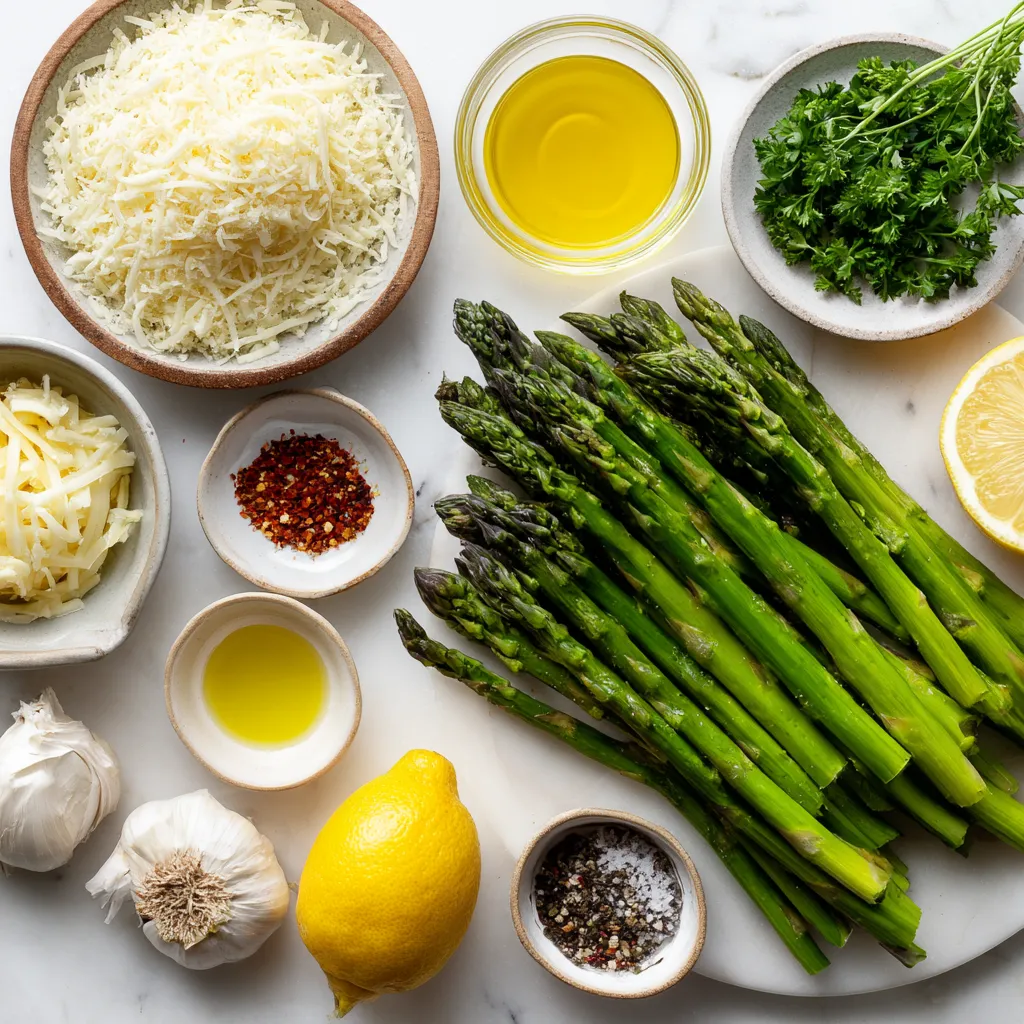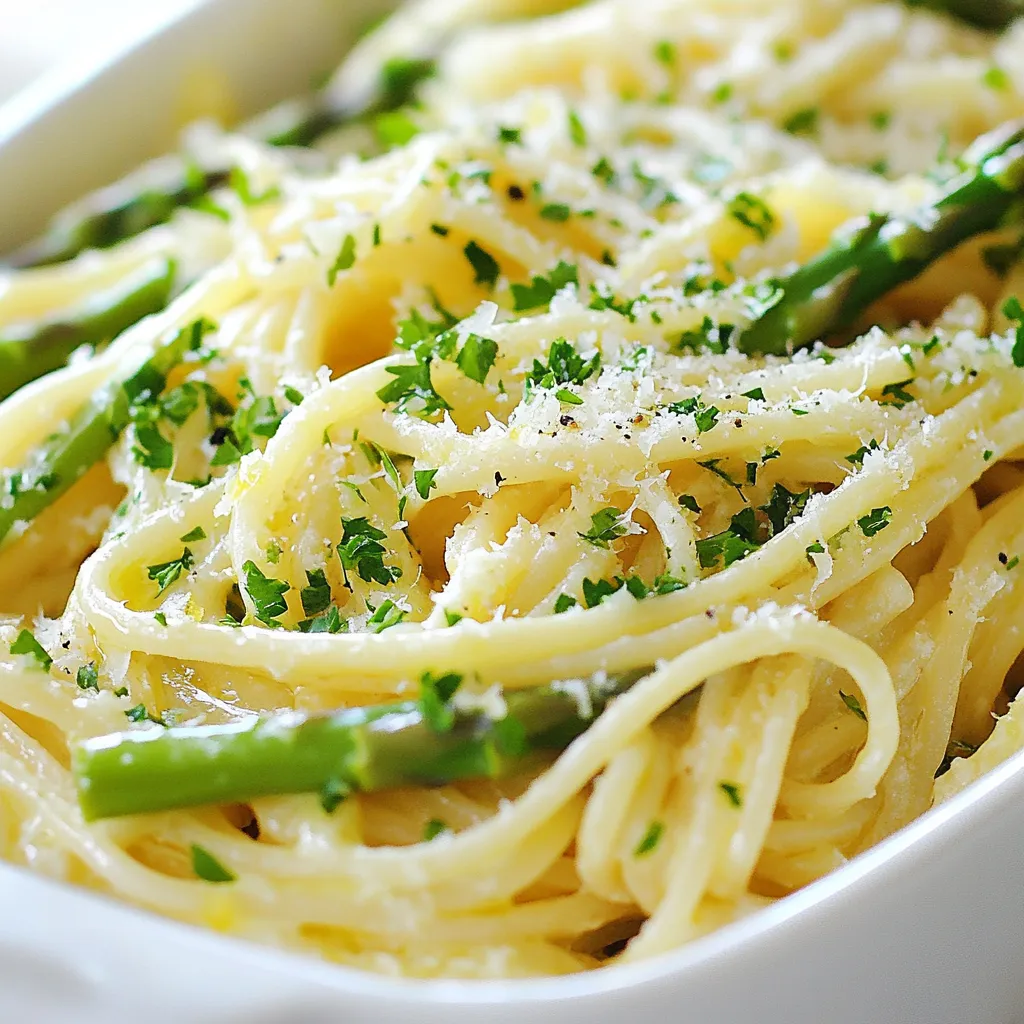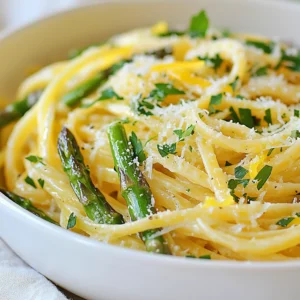WANT TO SAVE THIS RECIPE?
If you’re craving a quick, fresh meal,I’ve got the perfect recipe for you: Lemon Garlic Asparagus Pasta. This dish is simple yet packed with flavor, making it a delightful choice for any night of the week. With just a few easy steps and ingredients, you can create a dish that impresses friends and family alike. Let’s dive into this vibrant recipe and get cooking!

Why I Love This Recipe
- Fresh and Flavorful: This dish combines the bright flavors of lemon and garlic with the fresh crunch of asparagus, creating a deliciously vibrant meal.
- Quick and Easy: With a total cooking time of just 20 minutes, this recipe is perfect for a busy weeknight dinner.
- Healthy Ingredients: Made with wholesome ingredients like asparagus and olive oil, this pasta dish is a nutritious choice that doesn’t compromise on taste.
- Customizable: Easily adapt this recipe by adding your favorite vegetables or protein, making it versatile for any dietary preference.
Ingredients
Main Ingredients List
To make Lemon Garlic Asparagus Pasta, gather these main ingredients:
– 8 oz fettuccine or spaghetti
– 1 lb asparagus, trimmed and cut into 2-inch pieces
– 4 cloves garlic, minced
– 3 tablespoons olive oil
– Zest of 1 lemon
– Juice of 1 lemon
– 1/2 cup grated Parmesan cheese (or nutritional yeast for a vegan option)
– Salt and pepper to taste
– Fresh parsley, chopped (for garnish)
These ingredients work together to create a fresh, bright dish. The lemon and garlic give it a light flavor, while the asparagus adds a nice crunch.
Optional Ingredients
You can add some optional ingredients to enhance the dish:
– 1 teaspoon red pepper flakes
This adds a slight heat, which can make the dish more exciting.
Recommended Serving Suggestions
I love to serve this pasta warm in bowls. Garnish with:
– Chopped fresh parsley
– Extra lemon zest
– A sprinkle of additional Parmesan cheese
These small touches make the dish look vibrant and inviting. Plus, they enhance the flavors, making each bite delicious. Enjoy your meal with a side of crusty bread or a fresh salad for a complete experience.

Step-by-Step Instructions
Cooking the Pasta
Start by boiling a large pot of salted water. This adds flavor to the pasta. Once the water is bubbling, add 8 oz of fettuccine or spaghetti. Cook it as directed on the package until it’s al dente. Before draining, save about 1 cup of that pasta water. This water is starchy and will help later.
Sautéing the Garlic and Asparagus
While the pasta cooks, grab a large skillet. Heat 3 tablespoons of olive oil over medium heat. Add 4 cloves of minced garlic and, if you like, 1 teaspoon of red pepper flakes. Sauté these for 1-2 minutes. You want the garlic fragrant but not burnt. Next, add 1 lb of trimmed asparagus cut into 2-inch pieces. Cook this for 3-4 minutes. Aim for tender yet crisp asparagus. Stir it often to cook evenly.
Combining Ingredients for Flavor
Once your pasta is drained, add it straight to the skillet with the asparagus. Now, pour in the reserved pasta water, the juice and zest of 1 lemon. Toss everything together to mix it well. Next, stir in 1/2 cup of grated Parmesan cheese. Mix until it’s all combined. Taste and adjust with salt and pepper. If it feels dry, add more reserved pasta water. Let it sit for a minute. This helps the flavors blend together beautifully.
Tips & Tricks
Perfecting the Texture of Pasta
To get the best pasta, cook it al dente. Al dente means the pasta is firm but not hard. Start boiling a large pot of salted water. Once boiling, add your pasta. Stir it so it does not stick. Follow the package instructions for the cooking time. Before you drain it, save about 1 cup of that pasta water. This water helps make the sauce creamy later.
Enhancing the Flavor with Seasoning
Garlic is key to flavor in this dish. Sauté the minced garlic in olive oil. Don’t let it burn, or it will taste bitter. Red pepper flakes add a nice kick if you like some heat. Always taste your dish before serving. Add salt and pepper to make the flavors pop. The fresh lemon juice and zest give this dish a bright taste.
Presentation Techniques for Serving
How you serve the pasta matters. Use deep bowls for a nice look. After plating the pasta, sprinkle chopped parsley on top. This adds color and freshness. You can also add more lemon zest and a bit of grated Parmesan. These little touches make your dish look gourmet and inviting.
Pro Tips
- Timing is Key: To ensure the asparagus stays crisp, add it to the skillet when the pasta is almost done cooking so everything finishes at the same time.
- Use Fresh Ingredients: Fresh asparagus and real garlic will elevate the dish’s flavor significantly compared to canned or pre-minced options.
- Adjust Creaminess: If you prefer a creamier texture, gradually add more reserved pasta water until you reach your desired consistency.
- Garnish Wisely: A squeeze of fresh lemon juice right before serving adds brightness, while extra Parmesan and parsley enhance both flavor and presentation.

Variations
Vegan Adaptations
You can easily make this dish vegan. Simply swap the Parmesan cheese for nutritional yeast. Nutritional yeast gives a cheesy flavor without dairy. Use the same amount as the cheese in the recipe. It adds a nice depth to the dish.
Alternative Vegetable Add-Ins
Feel free to mix in other veggies. Broccoli, bell peppers, or peas work great here. You can also add spinach for a pop of color. Just remember to cook them until tender. This way, they blend well with the pasta.
Different Types of Pasta to Use
While fettuccine or spaghetti shines in this dish, you can try others. Penne or farfalle can add fun shapes. Whole wheat or gluten-free pasta also works well. Just adjust the cooking time according to the package. Enjoy experimenting with your favorite pasta!
Storage Info
Best Storage Practices
To keep your Lemon Garlic Asparagus Pasta fresh, store it in an airtight container. Let the pasta cool for about 30 minutes before sealing it. This helps prevent moisture buildup. You can keep it in the fridge for up to three days. If you want to enjoy it later, consider separating the sauce from the pasta. This keeps the pasta from getting too soggy.
Reheating Instructions
When you’re ready to eat, heat the pasta in a skillet over low heat. Add a splash of water or olive oil to prevent sticking. Stir gently until warmed through. You can also use a microwave. Place the pasta in a microwave-safe dish and cover it. Heat in short bursts, stirring in between, until hot. Make sure to monitor it closely to avoid overheating.
Freezing for Future Meals
If you want to freeze your Lemon Garlic Asparagus Pasta, do it right after cooking. Portion it into freezer bags or containers. Remove as much air as possible before sealing. You can freeze it for up to two months. To enjoy it later, thaw it overnight in the fridge. Reheat as mentioned above, and you’ll have a quick meal ready to go!
FAQs
Can I use frozen asparagus?
Yes, you can use frozen asparagus. Just thaw and drain it first. Frozen asparagus cooks faster than fresh. Keep an eye on it to avoid overcooking. This helps keep the texture nice and crisp.
How do I make this dish gluten-free?
To make this dish gluten-free, use gluten-free pasta. Many brands offer great options like brown rice or quinoa pasta. They cook similarly to regular pasta. Just follow the package instructions for the best results.
What can I substitute for Parmesan cheese?
For a cheese substitute, try nutritional yeast. It gives a nice, cheesy flavor. You can also use vegan Parmesan if you want a similar taste. Crushed cashews or sunflower seeds can work too!
How spicy is this recipe with red pepper flakes?
The spice level depends on how much you add. One teaspoon gives a nice warmth without being too hot. If you want more heat, add more red pepper flakes. Start with a little and taste as you go!
This blog post shared how to make a tasty pasta dish. You learned about key ingredients, cooking steps, and tips for great flavor. We also explored variations to suit different diets and how to store leftovers. Enjoying this dish is simple, no matter your taste. Remember, small tweaks can make a big difference. Keep experimenting with flavors and textures. Your next pasta creation will impress everyon
Lemon Garlic Asparagus Pasta
A light and flavorful pasta dish featuring asparagus, garlic, and lemon.
Prep Time 10 minutes mins
Cook Time 10 minutes mins
Total Time 20 minutes mins
Course Main Course
Cuisine Italian
Servings 4
Calories 400 kcal
- 8 oz fettuccine or spaghetti
- 1 lb asparagus, trimmed and cut into 2-inch pieces
- 4 cloves garlic, minced
- 3 tablespoons olive oil
- 1 teaspoon red pepper flakes (optional)
- 1 lemon zest
- 1 lemon juice
- 1/2 cup grated Parmesan cheese (or nutritional yeast for a vegan option)
- to taste salt and pepper
- to taste fresh parsley, chopped (for garnish)
Bring a large pot of salted water to a boil. Cook the pasta according to package instructions until al dente. Reserve about 1 cup of pasta water before draining the pasta.
While the pasta is cooking, heat olive oil in a large skillet over medium heat. Add minced garlic and red pepper flakes (if using), and sauté for 1-2 minutes until fragrant, being careful not to burn the garlic.
Add the asparagus to the skillet and cook for about 3-4 minutes until tender yet crisp. Stir occasionally to ensure even cooking.
Once the pasta is drained, add it directly to the skillet with the asparagus.
Pour in the reserved pasta water, lemon juice, and lemon zest, and toss everything together.
Stir in the grated Parmesan cheese, mixing until well combined. Adjust salt and pepper to taste. If the pasta seems dry, add more reserved pasta water as needed for creaminess.
Remove from heat and let it sit for a minute to meld the flavors.
Serve with extra lemon zest and Parmesan for enhanced flavor.
Keyword asparagus, lemon, pasta, vegetarian
WANT TO SAVE THIS RECIPE?





